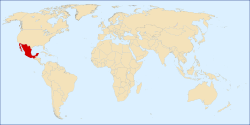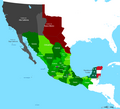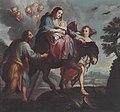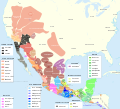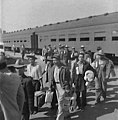Portal:Mexico
|
The Temple of Warriors at Chichen Itza, Mexico
¡Bienvenido! Welcome to the Mexico portal
Mexico, officially the United Mexican States, is a country in the southern portion of North America. It covers 1,972,550 km2 (761,610 sq mi), making it the world's 13th-largest country by area; with a population of almost 130 million, it is the 10th-most-populous country and the most populous Spanish-speaking country. Mexico is organized as a federal constitutional republic comprising 31 states and Mexico City, its capital. It shares land borders with the United States to the north, with Guatemala and Belize to the southeast; as well as maritime borders with the Pacific Ocean to the west, the Caribbean Sea to the southeast, and the Gulf of Mexico to the east.
This is a Featured article, which represents some of the best content on English Wikipedia.
The Fredonian Rebellion (December 21, 1826 – January 31, 1827) was the first attempt by Texans to secede from Mexico. The settlers, led by Empresario Haden Edwards, declared independence from Mexican Texas and created the Republic of Fredonia near Nacogdoches. The short-lived republic encompassed the land the Mexican government had granted to Edwards in 1825 and included areas that had been previously settled. Edwards's actions soon alienated the established residents, and the increasing hostilities between them and settlers recruited by Edwards led Víctor Blanco of the Mexican government to revoke Edwards's contract. In late December 1826, a group of Edwards's supporters took control of the region by arresting and removing from office several municipality officials affiliated with the established residents. Supporters declared their independence from Mexico. Although the nearby Cherokee tribe initially signed a treaty to support the new republic because a prior agreement with the Mexican government negotiated by Chief Richard Fields was ignored, overtures from Mexican authorities and respected empresario, Stephen F. Austin, convinced tribal leaders to repudiate the rebellion. On January 31, 1827, a force of over 100 Mexican soldiers and 275 Texian Militia marched into Nacogdoches to restore order. Haden Edwards and his brother Benjamin Edwards fled to the United States. Chief Fields was killed by his own tribe. A local merchant was arrested and sentenced to death but later paroled. (Full article...)Selected article -The Mexican Revolution (Spanish: Revolución Mexicana) was an extended sequence of armed regional conflicts in Mexico from 20 November 1910 to 1 December 1920. It has been called "the defining event of modern Mexican history" and resulted in the destruction of the Federal Army, its replacement by a revolutionary army, and the transformation of Mexican culture and government. The northern Constitutionalist faction prevailed on the battlefield and drafted the present-day Constitution of Mexico, which aimed to create a strong central government. Revolutionary generals held power from 1920 to 1940. The revolutionary conflict was primarily a civil war, but foreign powers, having important economic and strategic interests in Mexico, figured in the outcome of Mexico's power struggles; the U.S. involvement was particularly high. The conflict led to the deaths of around one million people, mostly noncombatants. Although the decades-long regime of President Porfirio Díaz (1876–1911) was increasingly unpopular, there was no foreboding in 1910 that a revolution was about to break out. The aging Díaz failed to find a controlled solution to presidential succession, resulting in a power struggle among competing elites and the middle classes, which occurred during a period of intense labor unrest, exemplified by the Cananea and Río Blanco strikes. When wealthy northern landowner Francisco I. Madero challenged Díaz in the 1910 presidential election and Díaz jailed him, Madero called for an armed uprising against Díaz in the Plan of San Luis Potosí. Rebellions broke out first in Morelos, and then to a much greater extent in northern Mexico. The Federal Army was unable to suppress the widespread uprisings, showing the military's weakness and encouraging the rebels. Díaz resigned in May 1911 and went into exile, an interim government was installed until elections could be held, the Federal Army was retained, and revolutionary forces demobilized. The first phase of the Revolution was relatively bloodless and short-lived. (Full article...)Selected pictureThis is a Good article, an article that meets a core set of high editorial standards.
The cactus wren (Campylorhynchus brunneicapillus) is a species of wren that is endemic to the deserts of the southwestern United States and northern and central Mexico. It is the state bird of Arizona, and the largest wren in the United States. Its plumage is brown, with black and white spots as markings. It has a distinctive white eyebrow that sweeps to the nape of the neck. The chest is white, whereas the underparts are cinnamon-buff colored. Both sexes appear similar. The tail, as well as flight feathers, are barred in black and white. Their song is a loud raspy chirrup; akin in the description of some ornithologists to the sound of a car engine that will not start. It is well-adapted to its native desert environment, and the birds can meet their water needs from their diet which consists chiefly of insects, but also of some plant matter. The cactus wren is a poor flier and generally forages for food on the ground. Ornithologists generally recognize seven subspecies, with the exact taxonomy under dispute. Its common name derives from their frequenting desert cactus plants such as the saguaro and cholla, building nests, roosting, and seeking protection from predators among them. Its bulky and globular nests are constructed of plant material and lined with feathers. They do not migrate; instead, they establish and defend the territories around their nests where they live all year-round. It lives in pairs, or as family groups from late spring through winter. Pairing among cactus wrens is monogamous; in each breeding season, the males chiefly build nests, the females incubate eggs, and both parents feed the young. (Full article...)Selected biography -Francisco Ignacio Madero González (Spanish pronunciation: [fɾanˈsisko jɣˈnasjo maˈðeɾo ɣonˈsales]; 30 October 1873 – 22 February 1913) was a Mexican businessman, revolutionary, writer and statesman, who served as the 37th president of Mexico from 1911 until he was deposed in a coup d'état in February 1913 and assassinated. He came to prominence as an advocate for democracy and as an opponent of President and de facto dictator Porfirio Díaz. After Díaz claimed to have won the fraudulent election of 1910 despite promising a return to democracy, Madero started the Mexican Revolution to oust Díaz. The Mexican revolution would continue until 1920, well after Madero and Díaz's deaths, with hundreds of thousands dead. A member of one of Mexico's wealthiest families, Madero studied business at the École des Hautes Études Commerciales de Paris. An advocate for social justice and democracy, his 1908 book The Presidential Succession in 1910 called Mexican voters to prevent the reelection of Porfirio Díaz, whose regime had become increasingly authoritarian. Bankrolling the opposition Anti-Reelectionist Party, Madero's candidacy garnered widespread support in the country. He challenged Díaz in the 1910 election, which resulted in his arrest. After Díaz declared himself winner for an eighth term in a rigged election, Madero escaped from jail, fled to the United States, and called for the overthrow of his regime in the Plan of San Luis Potosí, sparking the Mexican Revolution. (Full article...)
In the news
Selected fare or cuisine -Tostilocos (also Dorilocos) are a popular Mexican antojito (street food) that consist of a varied mix of ingredients that usually includes Tostitos or Doritos tortilla chips, topped with cueritos (pickled pork rinds), cucumber, jícama, lime juice, hot sauce, chamoy, chili powder, salt, and "Japanese peanuts" (sometimes referred to as "cracker nuts"). The dish was first conceived in the late 1990s by street vendors in Mexico. In the 21st century, Tostilocos are now commonly sold by street vendors, stadium vendors, and at Mexican juice bars in both Mexico and the Southwestern United States. (Full article...)
General imagesThe following are images from various Mexico-related articles on Wikipedia.
CategoriesTopicsRelated portalsWikiProjectYou are invited to participate in WikiProject Mexico, a WikiProject dedicated to developing and improving articles about Mexico. Associated WikimediaMore portals | ||||||||||




